Characteristics of Airflow Reversal of Excavation Roadway after a Coal and Gas Outburst Accident
Abstract
1. Introduction
2. Ventilation System and Its Simplification
3. Indexes of Airflow Disorder
3.1. Parameters of Outburst Accident
3.2. Physical Conditions of Roadway
3.3. Safety and Stability of Mine Ventilation System
4. Orthogonal Experiment
4.1. Orthogonal Design
4.2. Mathematical Experiment Modeling
4.2.1. Physical Model and Meshing
4.2.2. Mathematical Model
4.2.3. Boundary Conditions
4.2.4. Controlling Parameters of Fluid Dynamics
4.3. Results of Numerical Simulation
5. Comprehensive Evaluation of Airflow Disorder
5.1. Fuzzy Comprehensive Optimization Theory
5.2. Quantification and Weight Analysis of the Factors
5.2.1. Factors
5.2.2. Weight
5.3. Results and Discussion
6. Conclusions
Author Contributions
Funding
Acknowledgments
Conflicts of Interest
References
- Zhang, Q.; Yang, C.L.; Li, X.C.; Li, Z.B.; Li, Y. Mechanism and classification of coal and gas outbursts in China. Adv. Civil Eng. 2021, 2021, 5519853. [Google Scholar] [CrossRef]
- Dong, G.F.; Liang, Y.P. Analysis of gas emission from outburst coal and formation conditions of countercurrent. Coal Sci. Technol. 2001, 4, 46–48. [Google Scholar]
- Kazakov, B.P.; Shalimov, A.V.; Semin, M.A. Stability of natural ventilation mode after main fan stoppage. Int. J. Heat Mass Tran. 2015, 86, 288–293. [Google Scholar] [CrossRef]
- Zhou, A.T.; Wang, K. Airflow stabilization in airways induced by gas flows following an outburst. J. Nat. Gas Sci. Eng. 2016, 35, 720–725. [Google Scholar] [CrossRef]
- Bascompta, M.; Sanmiquel, L.; Zhang, H. Airflow stability and diagonal mine ventilation system optimization: A case study. J. Min. Sci. 2018, 54, 813–820. [Google Scholar] [CrossRef]
- Feng, B.; Zhou, A.T.; Xu, X.H.; Ren, Y.Q. Research on the relationship between coal and gas outburst strength and shock wave overpressure. Min. Eng. Res. 2011, 26, 22–26. [Google Scholar]
- Otuonye, F.; Sheng, J. A numerical simulation of gas flow during coal/gas outbursts. Geotech. Geol. Eng. 1994, 12, 15–34. [Google Scholar] [CrossRef]
- Zhang, X.X.; Cheng, J.W.; Shi, C.L.; Xu, X.; Borowski, M.; Wang, Y. Numerical simulation studies on effects of explosion impact load on underground mine seal. Min. Metall. Explor. 2020, 37, 665–680. [Google Scholar] [CrossRef]
- Yang, C.L.; Li, X.C. Statistical analysis of the causes and rules of especially serious gas and coal dust explosion accident in coal mine. Coal Technol. 2015, 34, 309–311. [Google Scholar]
- Cheng, J.W.; Wang, Z.; Li, S.Y.; Song, W.T.; Lu, W.D.; Zhang, Y.J.; Zhao, K. Subsurface strata failure and movement analyses based for improving gas emission control: Model development and application. Energy Sci. Eng. 2020, 8, 3285–3302. [Google Scholar] [CrossRef]
- Xue, S.; Zheng, C.S.; Jiang, B.Y.; Zheng, X.L. Effective potential energy associated with coal and gas outburst during underground coal mining: Case studies for mining safety. Arab. J. Geosci. 2021, 14, 1–12. [Google Scholar] [CrossRef]
- Hong, L.; Gao, D.M.; Wang, J.R.; Zheng, D. The power source for coal and gas outburst. J. Min. Sci. 2019, 55, 239–246. [Google Scholar] [CrossRef]
- Wei, L.J.; Li, S.; Wei, Z.K.; Wang, M.W. Research status and prospect of influence law of coal and gas outburst on ventilation system. Coal Sci. Technol. 2021, 49, 1–7. [Google Scholar]
- Ul’yanova, E.V.; Malinnikova, O.N.; Pashichev, B.N.; Malinnikova, E.V. Microstructure of coal before and after gas-dynamic phenomena. J. Mining Sci. 2019, 55, 701–707. [Google Scholar] [CrossRef]
- Li, C.W.; Yang, W.; Wei, S.Y.; Li, T.; Chi, L.L. Experimental study on influence range of disaster gas after coal and gas outburst. J. China Coal Soc. 2014, 39, 478–485. [Google Scholar]
- Xu, J.; Cheng, L.; Zhou, B.; Peng, S.J.; Yang, X.B.; Yang, W.J. Physical simulation of coal-gas two-phase flow migration during outburst. Chin. J. Rock Mech. Eng. 2019, 38, 1945–1953. [Google Scholar]
- Wu, X.; Xu, J. Numerical simulation of gas ventilation safety in coal and gas outburst process simulation laboratory. Min. Saf. Environ. Prot. 2010, 37, 5–8, 12. [Google Scholar]
- Feng, Y.F.; Wu, Z.Q.; Zhou, A.T. Flow reversals in bypass branch of ascensionally ventilated roadway after coal and gas outburst. China Coal 2012, 83–87. [Google Scholar] [CrossRef]
- Yu, X.P.; Huang, S.J. Research on application of downward ventilation to coal mining face in horizontal seam with coal outburst in potential. Coal Sci. Technol. 2005, 6, 27. [Google Scholar] [CrossRef]
- Zhou, A.T.; Wang, K.; Wu, Z.Q. Propagation law of shock waves and gas flow in cross roadway caused by coal and gas outburst. J. Min. Sci. Technol. 2014, 24, 23–29. [Google Scholar] [CrossRef]
- Zhou, A.T.; Wang, K.; Wu, Z.Q.; Li, S. Research on airflow catastrophic law induced by gas pressure in mine. J. China Univ. Min. Technol. 2014, 43, 1011–1018. [Google Scholar]
- Wang, K.; Wu, Z.Q.; Zhou, A.T.; Yu, X.; Shen, S.K. Influence of lateral branch wind resistance on wind reversal induced by gas wind pressure. J. Basic Sci. Eng. 2018, 26, 538–549. [Google Scholar]
- Li, Z.X.; Liu, Y.; Yu, J.X.; Jia, J.Z. Coupling movement simulation of outburst gas flow and mine ventilation system. J. Chongqing Univ. 2012, 35, 111–116, 135. [Google Scholar]
- Li, Z.X.; Li, L.; Yu, J.X.; Han, G. Simulation study on disaster ventilation system of bidirectional burst source in coal face. J. Nat. Disasters 2013, 22, 185–190. [Google Scholar]
- Cheng, W.M.; Wang, G.; Zhou, G.; Chen, L.J. Numerical simulation of blast damper failure after coal and gas outburst. J. Chongqing Univ. 2009, 32, 314–318. [Google Scholar]
- Dai, S.H.; Wang, Z.T.; Xu, Y. Static and dynamic analysis of the structural safety of steel blast gates. China Saf. Sci. J. 2017, 27, 74–79. [Google Scholar]
- Huang, S.J.; Ma, X.X.; Cai, Y. Calculation of influence of outburst gas on ventilation system. Min. Saf. Environ. Prot. 2000, 2, 16–18. [Google Scholar]
- Li, Z.X.; Wang, Y.D.; Gao, G.C. 3D simulation of coal mine disaster ventilation based on active wind network. China Saf. Sci. J. 2015, 25, 43–49. [Google Scholar]
- Wang, K.; Jiang, S.G.; Zhang, W.Q. Destruction mechanism of gas explosion to ventilation facilities and automatic recovery technology. J. Min. Sci. Technol. 2012, 22, 417–422. [Google Scholar] [CrossRef]
- Wu, X.; Cheng, W.Y.; Miu, Y. Research on establishing the indexes system of controlling the coal and gas outburst accident. Procedia Eng. 2011, 26, 2018–2026. [Google Scholar]
- Zhang, C.L.; Wang, E.Y.; Xu, J.; Peng, S.J. A new method for coal and gas outburst prediction and prevention based on the fragmentation of ejected coal. Fuel 2021, 287, 119493. [Google Scholar] [CrossRef]
- Zhai, C.; Xiang, X.W.; Xu, J.Z.; Wu, S.L. The characteristics and main influencing factors affecting coal and gas outbursts in Chinese Pingdingshan mining region. Nat. Hazards 2016, 82, 507–530. [Google Scholar] [CrossRef]
- Yin, S.Y.; Wu, S.P.; Liu, M.B.; You, Z.L. Study on influencing factors of unconfined penetration test based on orthogonal design. Arab. J. Geosci. 2021, 14, 124. [Google Scholar] [CrossRef]
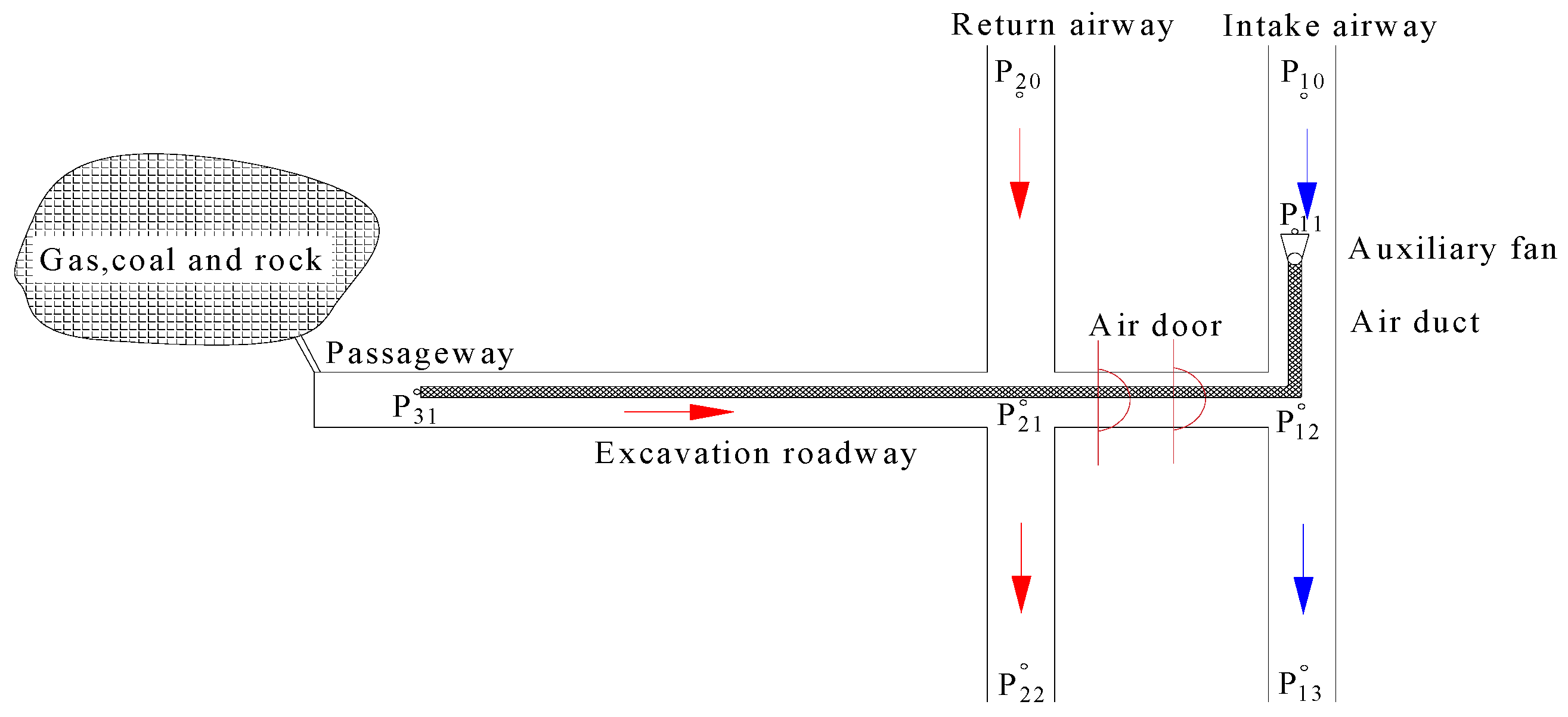
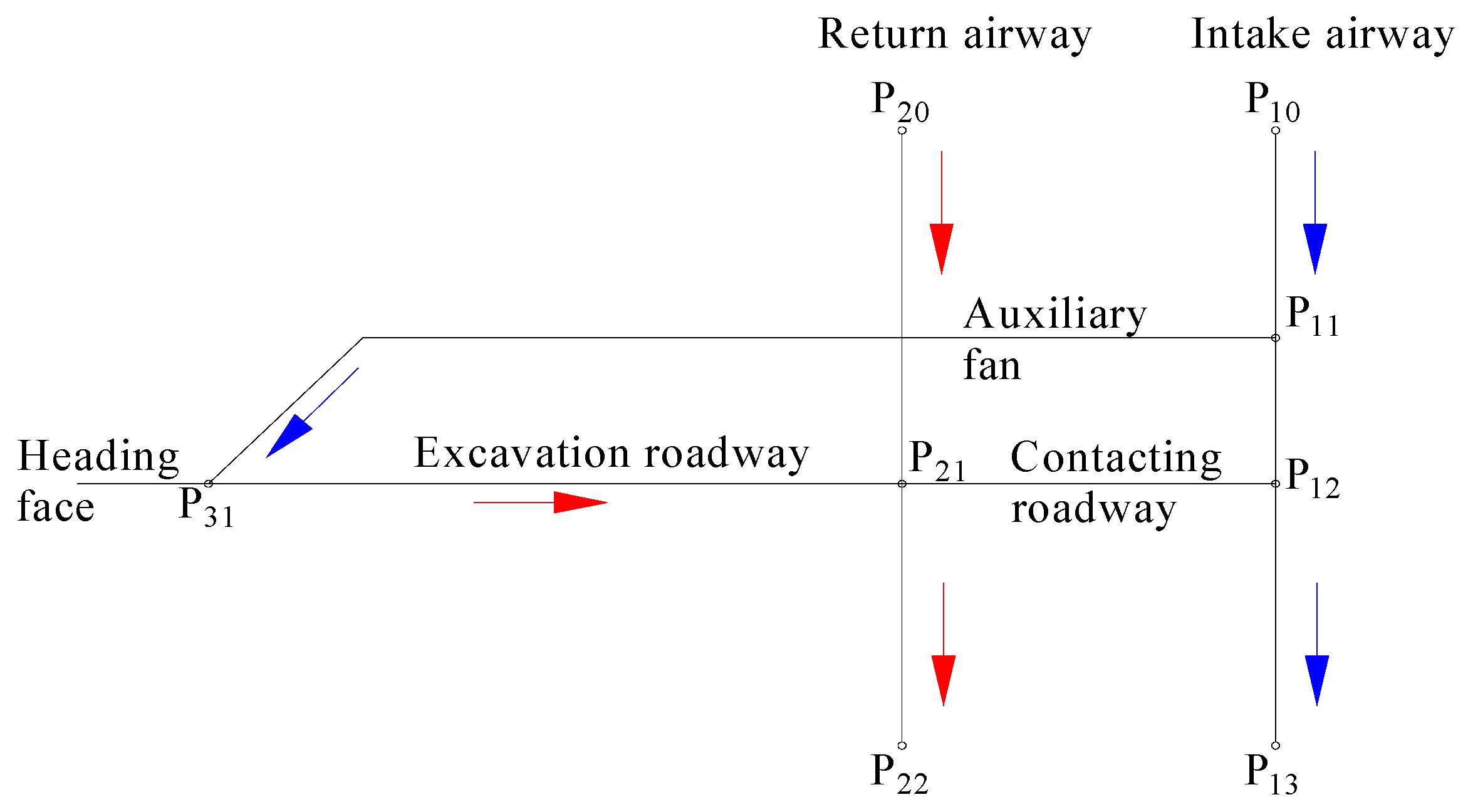
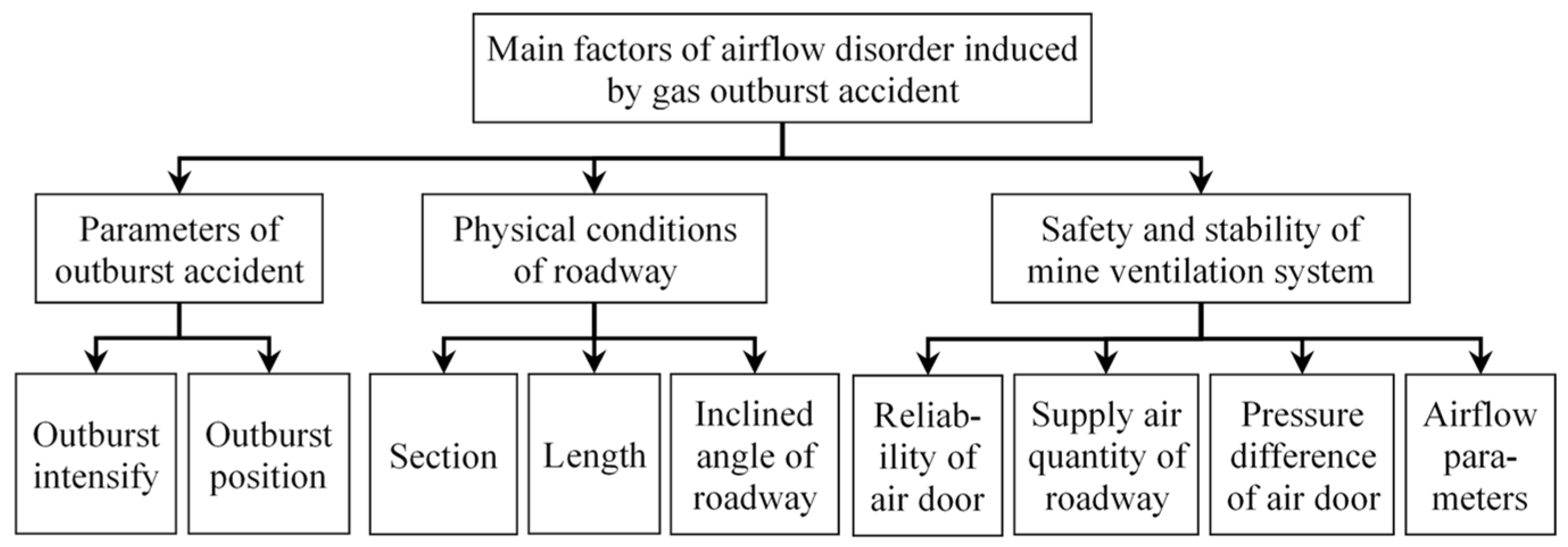
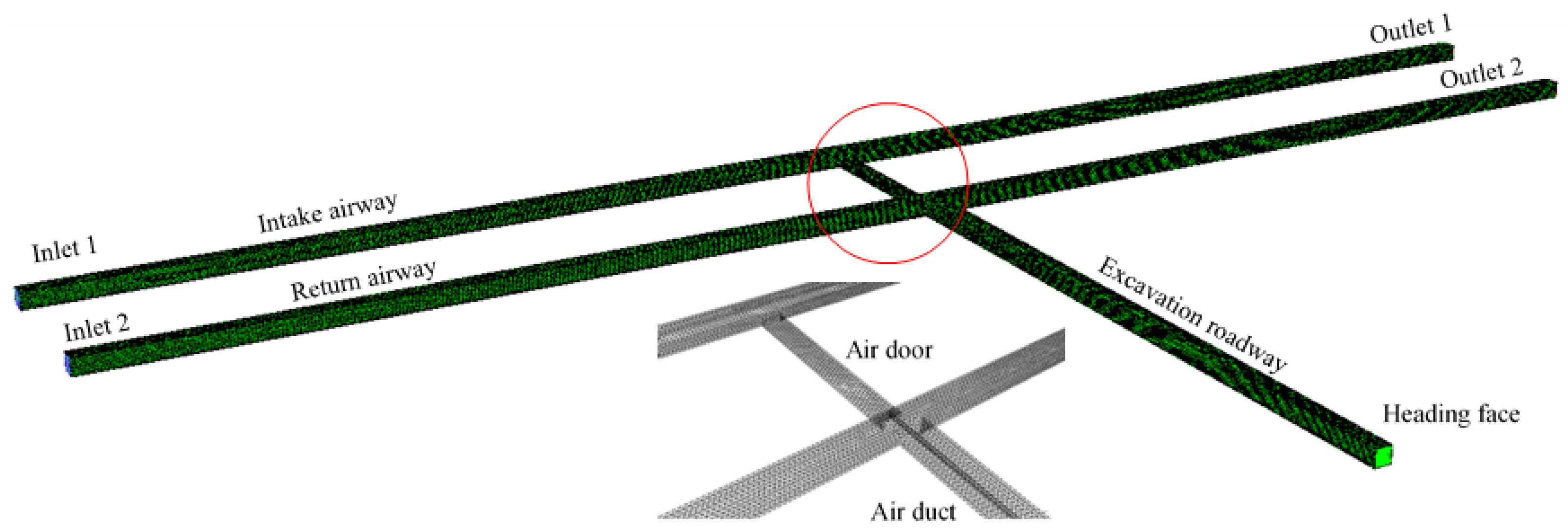
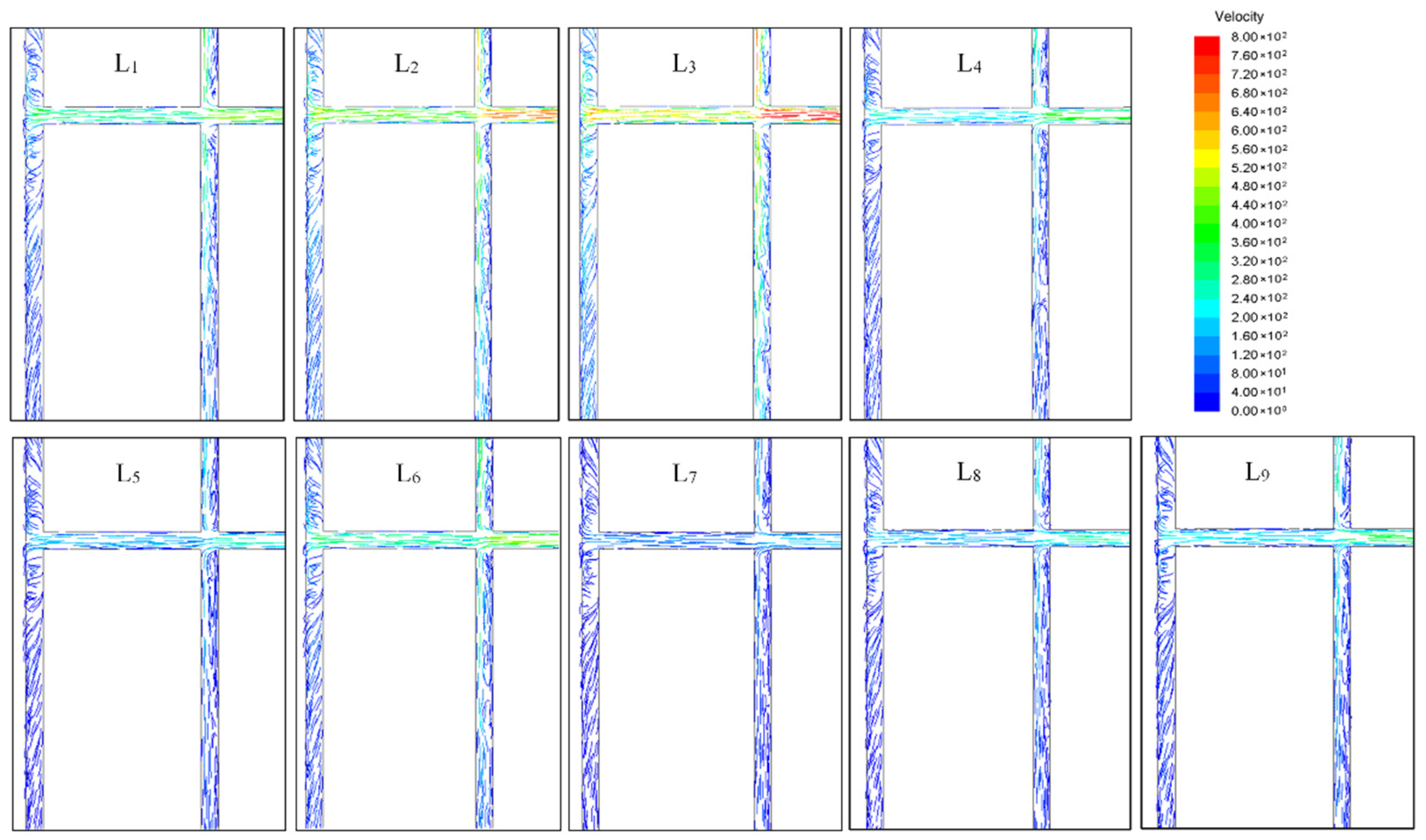




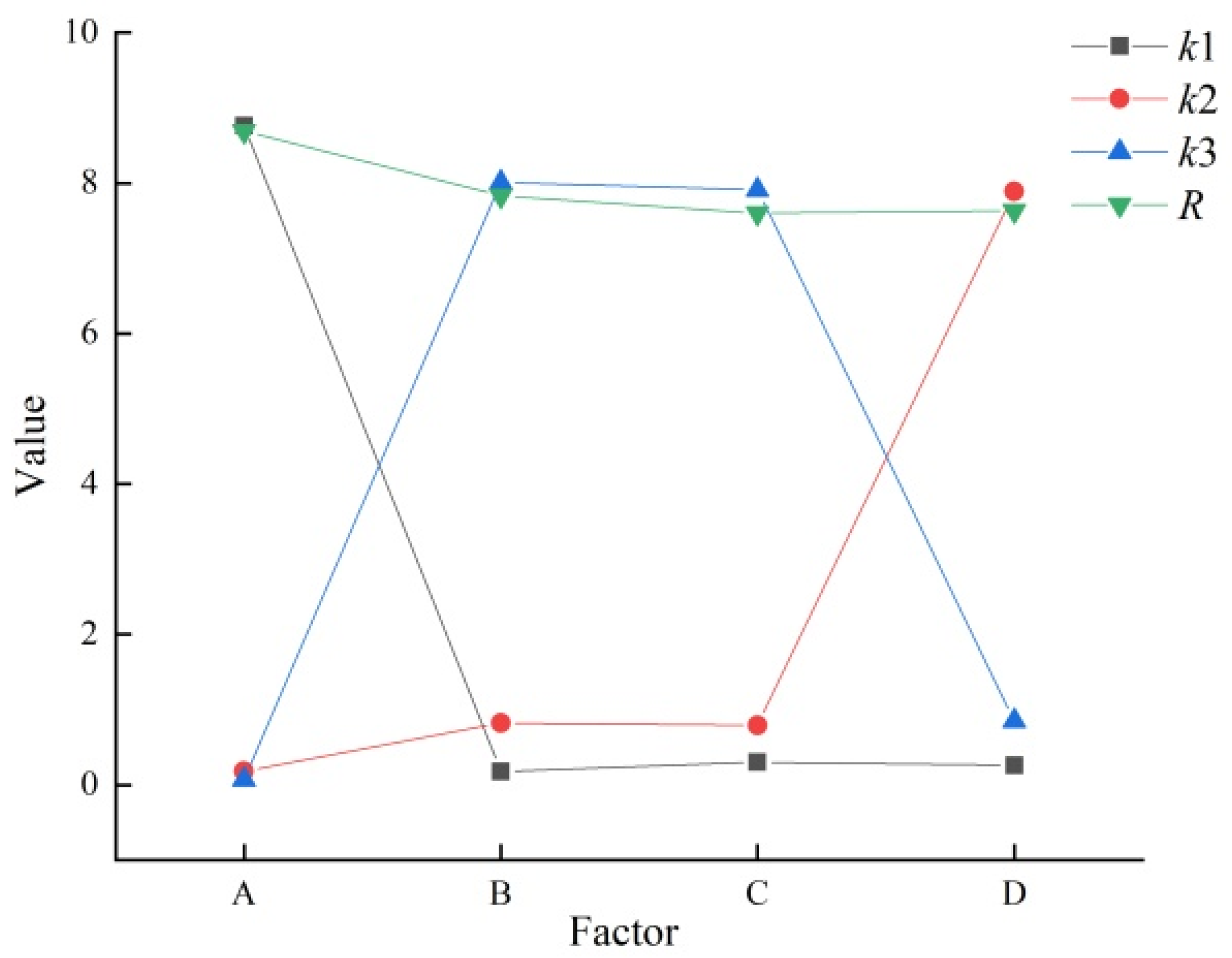
| Test Number | A/m | B/MPa | C/Pa | D/m3·min−1 |
|---|---|---|---|---|
| L1 | 200 | 0.1 | 500 | 240 |
| L2 | 200 | 0.2 | 1000 | 1200 |
| L3 | 200 | 0.3 | 1500 | 600 |
| L4 | 1000 | 0.2 | 1500 | 240 |
| L5 | 1000 | 0.1 | 1000 | 600 |
| L6 | 1000 | 0.3 | 500 | 1200 |
| L7 | 2000 | 0.1 | 1500 | 1200 |
| L8 | 2000 | 0.2 | 500 | 600 |
| L9 | 2000 | 0.3 | 1000 | 240 |
| Test | Length of Excavation Roadway/m | Model Size | Number of Grids | |||
|---|---|---|---|---|---|---|
| Excavation Roadway Length × Width × Height/m | Air Duct Length × Radium/m | Connecting Roadway Length × Width × Height/m | Intake and Return Airway Length × Width × Height/m | |||
| L1, L2, L3 | 200 | 200 × 5 × 5 | 200 × 0.5 | 45 × 5 × 2 | 500 × 5 × 5 | 237,342 |
| L4, L5, L6 | 1000 | 1000 × 5 × 5 | 1000 × 0.5 | 463,984 | ||
| L7, L8, L9 | 2000 | 2000 × 5 × 5 | 2000 × 0.5 | 764,081 | ||
| Test | Inlet Boundary | Outlet Boundary | ||||
|---|---|---|---|---|---|---|
| Inlet 2/Pa | Inlet 1/Pa | Auxiliary Fan Inlet/m·s−1 | Outburst Position/MPa | Outlet 2/Pa | Outlet 1/Pa | |
| L1 | 37.97 | 537.97 | 5.10 | 0.1 | 0 | 503.84 |
| L2 | 46.88 | 1046.88 | 25.48 | 0.2 | 0 | 1019.20 |
| L3 | 41.12 | 1541.12 | 12.74 | 0.3 | 0 | 1509.60 |
| L4 | 37.97 | 1537.97 | 5.10 | 0.2 | 0 | 1503.84 |
| L5 | 41.12 | 1041.12 | 12.74 | 0.1 | 0 | 1009.60 |
| L6 | 46.88 | 546.88 | 25.48 | 0.3 | 0 | 519.20 |
| L7 | 46.88 | 1546.88 | 25.48 | 0.1 | 0 | 1519.20 |
| L8 | 41.12 | 541.12 | 12.74 | 0.2 | 0 | 509.60 |
| L9 | 37.97 | 1037.97 | 5.10 | 0.3 | 0 | 1003.84 |
| Test | Maximum Air Velocity/m·s−1 | Airflow Reversal Degree | ||
|---|---|---|---|---|
| Inlet 2 | Inlet 1 | Inlet 2 | Inlet 1 | |
| L1 | −142.30 | −74.23 | −48.43 | −25.74 |
| L2 | −206.40 | −111.39 | −69.80 | −38.13 |
| L3 | −252.70 | −137.31 | −85.23 | −46.77 |
| L4 | −112.65 | −53.79 | −38.55 | −18.93 |
| L5 | −78.30 | −34.47 | −27.10 | −12.49 |
| L6 | −137.58 | −68.94 | −46.86 | −23.98 |
| L7 | −55.78 | −18.66 | −19.59 | −7.22 |
| L8 | −80.26 | −38.06 | −27.75 | −13.69 |
| L9 | −98.28 | −48.59 | −33.76 | −17.20 |
| Factors | A | B | C | D |
|---|---|---|---|---|
| K1 | 26.27 | 0.53 | 0.91 | 0.77 |
| K2 | 0.54 | 2.45 | 2.38 | 23.67 |
| K3 | 0.20 | 24.02 | 23.72 | 2.56 |
| k1 | 8.76 | 0.18 | 0.30 | 0.26 |
| k2 | 0.18 | 0.82 | 0.79 | 7.89 |
| k3 | 0.07 | 8.01 | 7.91 | 0.85 |
| R | 8.69 | 7.83 | 7.60 | 7.63 |
Publisher’s Note: MDPI stays neutral with regard to jurisdictional claims in published maps and institutional affiliations. |
© 2021 by the authors. Licensee MDPI, Basel, Switzerland. This article is an open access article distributed under the terms and conditions of the Creative Commons Attribution (CC BY) license (https://creativecommons.org/licenses/by/4.0/).
Share and Cite
Si, J.; Li, L.; Cheng, J.; Wang, Y.; Hu, W.; Li, T.; Li, Z. Characteristics of Airflow Reversal of Excavation Roadway after a Coal and Gas Outburst Accident. Energies 2021, 14, 3645. https://doi.org/10.3390/en14123645
Si J, Li L, Cheng J, Wang Y, Hu W, Li T, Li Z. Characteristics of Airflow Reversal of Excavation Roadway after a Coal and Gas Outburst Accident. Energies. 2021; 14(12):3645. https://doi.org/10.3390/en14123645
Chicago/Turabian StyleSi, Junhong, Lin Li, Jianwei Cheng, Yiqiao Wang, Wei Hu, Tan Li, and Zequan Li. 2021. "Characteristics of Airflow Reversal of Excavation Roadway after a Coal and Gas Outburst Accident" Energies 14, no. 12: 3645. https://doi.org/10.3390/en14123645
APA StyleSi, J., Li, L., Cheng, J., Wang, Y., Hu, W., Li, T., & Li, Z. (2021). Characteristics of Airflow Reversal of Excavation Roadway after a Coal and Gas Outburst Accident. Energies, 14(12), 3645. https://doi.org/10.3390/en14123645






